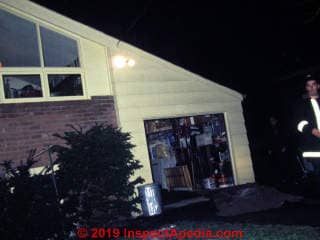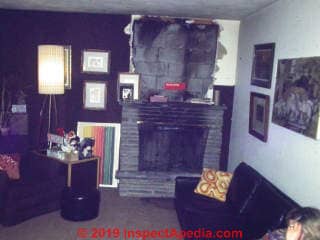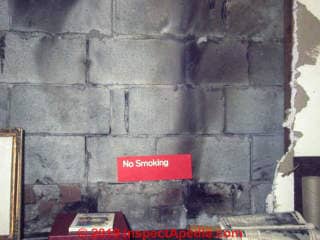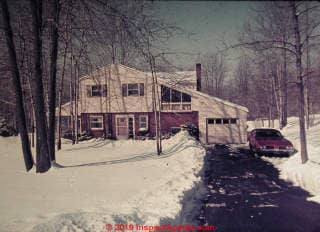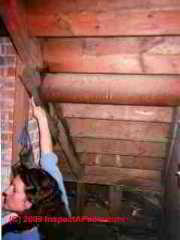 Definition & Explanation of Pyrolysis
Definition & Explanation of Pyrolysis
How
repeated heating lowers the combustion point of wood: King Drive house fire
- POST a QUESTION or COMMENT about about Pyrolysis: what is pyrolysis (often misspelled as pyrolosis), how does wood change chemically to have a lower combustion point
Definition of pyrolysis & why you should care:
This article defines pyrolysis - the chemical change that occurs in wood and other materials, lowering the material combustion point in response to repeated heating at even relatively low temperatures such as around 200F.
An understanding of the meaning and process of pyrolysis forms the basis of standards & requirements for clearances from combustibles, such as the required distances between a flue vent connector or chimney or woodstove and nearby wood framing or other potentially flammable materials. In our page top photo our inspection client is pointing to inadequate clearance between a flue vent connector and wood framing.
InspectAPedia tolerates no conflicts of interest. We have no relationship with advertisers, products, or services discussed at this website.
- Daniel Friedman, Publisher/Editor/Author - See WHO ARE WE?
Pyrolysis: Why Fire Clearances from Wood Materials are Critical
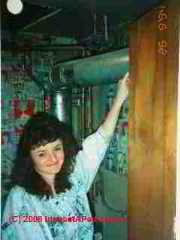 The reason that building codes specify a healthy distance between wood materials (or other combustibles) and flue vent connectors is not just that the heat from the flue will immediately set the wood on fire.
The reason that building codes specify a healthy distance between wood materials (or other combustibles) and flue vent connectors is not just that the heat from the flue will immediately set the wood on fire.
Rather it is also that wood that has been heated over time, even to the relatively low temperature of 200 to 300F, will be chemically affected to become more readily combustible.
Our photo at left shows how wood-to-combustible clearance hazards can be tricky to spot - only when this wood door was left open was it in contact with a heating flue.
[Click to enlarge any image]
Definition of pyrolysis and How it Causes an Increase in the Risk of Building Fire
Pyrolysis is defined as the chemical or thermal decomposition of a material when it is exposed to heat.
Watch out: Actual fire also "decomposes" combustible material, but in a fire the material is burned or decomposed both visibly and rapidly - dramatically. In contrast, pyrolysis can decompose material also lowering its combustion or ignition point to begin an actual fire, with no visible change in the external appearance of the material, particularly in the case of wood framing.
Wood exposed to heat, such as wood framing too close to a metal chimney in a building, is chemically transformed in an important way: its ignition point or combustion point is lowered - the wood can actually catch fire at a lower temperature.
This means that by pyrolysis, wood and some other combustibles found in buildings are chemically changed by exposure to even relatively low but warm temperatures over time.
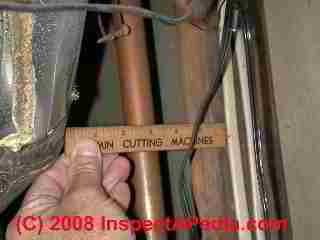 The chemical change of pyrolysis lowers the temperature at which a substance will catch fire. What may be surprising is that wood exposed to temperatures as low as 200 degF. can over time be changed such that its ignition point or combustion point is significantly lowered.
The chemical change of pyrolysis lowers the temperature at which a substance will catch fire. What may be surprising is that wood exposed to temperatures as low as 200 degF. can over time be changed such that its ignition point or combustion point is significantly lowered.
In our photo (above/left) I'm hold ing a ruler showing that we have only 4 3/4" between an oil fired heating appliance flue vent connector and nearby wood framing.
Considering that in at un-tuned or dirty oil fired boiler I've measured stack temperatures at a terrifying 1000 degF., it should not be a surprise that pyrolysis is a real hazard in cases such as this one.
Because that chemical change occurs over time as a function of the frequency and duration of exposure of the wood to high temperatures, we can understand that a building owner may use an improperly-installed fireplace, woodstove or other heating device (lacking adequate fire clearance from combustibles) for quite some time before a fire occurs.
Or a fire may not occur after prolonged pyrolysis until a new user happens to build a hotter fire in the woodstove or some other similar change in conditions occurs.
In sum, a fireplace, wood stove, other heating appliance, chimney, or a flue vent connector may have been too close to wood framing for decades before unexpectedly causing the nearby combustible building components to catch fire.
Other Definitions of Pyrolysis - in Creation of Bio Fuels or Charcoal at low oxygen levels
The process of pyrolysis discussed above occurs at relatively low temperatures (200 F) and without attempting to restrict the level of oxygen, in processes that are well-studied and well defined in sources we cite below in this article at References on the chemistry of pyrolysis particularly Shafizadeh (1984) who points out that pyrolysis of wood includes an initial low-temperature process:
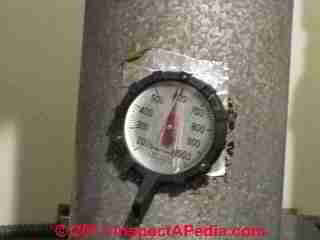 The first pathway, which dominates at temperatures below 300 °C, involves reduction in the degree of polymerization by bond scission; elimination of water; formation of free radicals, carbonyl, carboxyl, and hydroperoxide groups; evolution of CO and CO2; and, finally, production of a highly reactive carbonaceous char. [6]
The first pathway, which dominates at temperatures below 300 °C, involves reduction in the degree of polymerization by bond scission; elimination of water; formation of free radicals, carbonyl, carboxyl, and hydroperoxide groups; evolution of CO and CO2; and, finally, production of a highly reactive carbonaceous char. [6]
That oil fired heating systems easily reach temperatures of 700F and higher is demonstrated by our thermometer measuring flue gas temperature at a modern oil fired heater that needed service.
Soot in the heat exchanger slows heat transfer into the hot water (or warm air if it's a furnace) thus sending more heat up the chimney and subjecting nearby building surfaces to high temperatures as well.
But pyrolysis is often defined differently or perhaps more narrowly in special applications. The production of charcoal by heating wood to high temperatures under conditions of very low oxygen is a process that has been used by humans for many centuries. A portion of a Wikipedia definition of pyrolysis is of interest and needs further comment:
Pyrolysis differs from other high-temperature processes like combustion and hydrolysis in that it usually does not involve reactions with oxygen, water, or any other reagents.
In practice, it is not possible to achieve a completely oxygen-free atmosphere. Because some oxygen is present in any pyrolysis system, a small amount of oxidation occurs.[23]
Key in understanding the relation between this definition and the changes in wood that we described earlier is the portion of this statement that includes "... does not involve reactions with oxygen ...".
The absence of a reaction with oxygen does not have to be due only to the unavailability of oxygen (as in the case of production of charcoal or biofuels).
The absence of a significant reaction with oxygen also may be due to the much lower temperature at which wood pyrolysis is occurring. It is also helpful to understand that low-temperature pyrolysis of wood is almost certainly an endothermic process - that is, a reaction in which the wood absorbs energy from its surroundings in the form of heat. [24]
More recently the U.S. Department of Agriculture's Agricultural Research Service, in discussing the production of biofuels from biomass, defines a higher-temperature use of pyrolysis in the absence of (much) oxygen as follows:
Pyrolysis is the heating of an organic material, such as biomass, in the absence of oxygen. Because no oxygen is present the material does not combust but the chemical compounds (i.e. cellulose, hemicellulose and lignin) that make up that material thermally decompose into combustible gases and charcoal.
Most of these combustible gases can be condensed into a combustible liquid, called pyrolysis oil (bio-oil), though there are some permanent gases (CO2, CO, H2, light hydrocarbons). Thus pyrolysis of biomass produces three products: one liquid, bio-oil, one solid, bio-char and one gaseous (syngas).[22]
...
Thus pyrolysis of biomass produces ... liquid, bio-oil, solid, bio-char and ... gaseous (syngas). ... all things being equal, the yield of bio-oil is optimized when the pyrolysis temperature is around 500 °C and the heating rate is high (i.e. 1000 °C/s) i.e. fast pyrolysis conditions. [22]
Field Report of Pyrolysis as a Factor in a House Fire or Chimney Fire
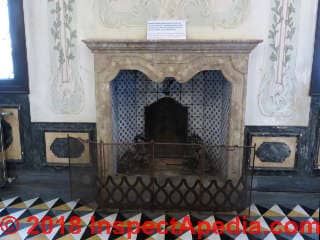 9 April 2015 NHFireBear said: "... long-term pyrolysis on the adjacent structure caused the spontaneous structure fire one cold night ..."
9 April 2015 NHFireBear said: "... long-term pyrolysis on the adjacent structure caused the spontaneous structure fire one cold night ..."
Our FD recently went to a "chimney fire", which turned out to be in the basement, where someone had connected a wood-fired boiler using horizontal single-wall pipe to the chimney.
Being less than 4 inches from bare wood, the gap stuffed with pink fiberglass, the intermittent and long-term pyrolysis on the adjacent structure caused the spontaneous structure fire one cold night when the wood reached its (reduced) ignition temperature.
Had they installed the proper pipe, or proper shielding and a 9-inch clearance, it would have been safe and approved, assuming they requested an inspection.
Photo: fireplace at the Palacio Brandolin Rota, Venice, Italy.
Reply: The Phil Hansee Special Fireplace Design: you just get ONE fire!
Indeed FireBear I've had first-hand exposure to similar pyrolysis hazards. Sometimes a fire occurs by the ignition of combustible material that has undergone pyrolysis over a period of years and when there is a change in building ownership or occupancy.
The old owner knew that there was a fire hazard - say from inadequate clearance from combustibles - and as one owner told me "Of course I knew it was dangerous, that's why I never built a big fire in the woodstove".
Then the home is sold, a new owner moves in and is excited to fire up that old wood-stove on the first very cold night. It's cold. They build a really hot fire, and boom!
Or I should say "snap crackle and pop" as the nearby wall begins to burn.
King Drive House Fire: Phil Hansey Fireplace 1973-1074: Is your wall supposed to glow like that?
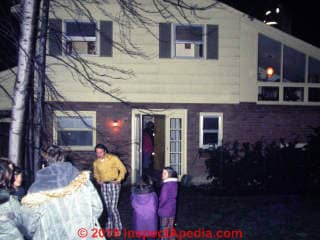 Harriet and I experienced a house fire caused by improper fireplace construction first hand in 1973 when a wood block exposed to heat in an improperly-built masonry fireplace caught fire, burned-through, and in turn acted as a chimney to set the wall above the hearth on fire.
Harriet and I experienced a house fire caused by improper fireplace construction first hand in 1973 when a wood block exposed to heat in an improperly-built masonry fireplace caught fire, burned-through, and in turn acted as a chimney to set the wall above the hearth on fire.
It was New Years Eve. New home, cold outside, hot fire in the fireplace. Dan Martin called our attention to an orange spot glowing through the drywall above the stone fireplace mantel.
"Is your wall ... supposed to glow like that?" Dan Martin asked as he passed me a fire extinguisher.
Just above the stone fireplace mantel, where drywall abutted the mantel surface we saw an orange glow: the drywall was burning right through!
Photo above: evacuating 25 King Drive, Poughkeepsie, NY during a New Year's Eve Fire, 31 December 1973.
First we got everyone out, including baby Michelle. Then we called the fire department. Look closely at the upper right corner of this photo: a Red Oaks Mill fire department fireman was charging up the roof to inspect for fire around the chimney and rooftop.
There was just enough snow and ice on the roof that even though it's slope was not steep, the firefighter was left clinging to the chimney at the rooftop until after the fire was out. Had he let go he'd have gone zooming down the ice-covered roof.
Then the Red Oaks Mill fire crew used a safety rope to get the rooftop firefighter down without further ado.
We got everyone out of the house, called the Red Oaks Mill fire department, and then hooked up a garden hose to our water heater - the only convenient spot - and began squirting out the fire in the fireplace - which did not do much to discourage the fire in the wall cavity.
The fire department was having their New Years' Eve party. So lots of fellows stopped by to help chop out walls and douse the house fire.
Photo above: the drywall above the Phill Hansey (Hansee) fireplace has been removed - and the tarp containing that debris has been dragged outside. To the right of the fireplace you can still see some of the brown cork tiles that we thought were so attractive glued to the drywall above and around the fireplace. Cork tiles make wonderful fire kindling.
That big stain on the carpeting in front of the fireplace hearth was from water we'd sprayed into the fireplace during the Phil Mansey-Fireplace house fire.
Above: the "No Smoking" sign is about where Dan Martin first saw our drywall glowing orange as the fire had spread up through blocking around the improperly-installed fireplace damper and was burning inside the wall cavity.
When the fire was out I asked the fire chief if he could tell me what caused the fire. He leaned down and looked up into the fireplace throat with his flashlight.
"Aaah, it's another Phil Hansee Fireplace" he said.
They knew this guy's work, which maybe tells us something worth remembering.
Poughkeepsie's Phil Hansee built all of his fireplaces the same way. It's lucky there were not more house fires where Phil's fireplaces were installed. Phil liked to set the outer lip of the cast iron fireplace damper on a cross-over 2x4 during fireplace construction.
His design left about an inch wide strip of wood exposed in the fireplace throat. In homes with a wood framed wall above the stone fireplace hearth, the framers rested the wall studs atop this very convenient horizontal 2x.
Even if the wood had not been exposed to view (making it impossible to discover) the heat from the fireplace and pyrolysis would risk an eventual building fire from this design feature.
All of Phil's fireplaces were built using that same feature.
Photo below: the home at which the fireplace fire occurred.
Mason Comes Out of Retirement to Build Another Unsafe Fireplace
I found one last fireplace of the Phil design more than 20 years later during a home inspection. The realtor and home buyer were admiring the stone work. I lay on the floor and looked up into the fireplace throat.
Realtor: "Think of how beautiful and cozy it will be for you next winter when you build your first fire in this new home."
Buyer: gushes. "Yes yes yes. Ummmm. I can just imagine the warmth."
Me: "There's just one thing though..." like an amateur Columbo I hesitated, trying to think of how to break the news that the wall needed to be torn out.
Buyer and realtor in chorus: "What's that?"
Me (still lying on my back on the floor shining my flashlight into the fireplace): "Well, you only get one fire, or maybe a few, then the house burns down. But what I can't understand is how this could be another Phil Hansee fireplace. Surely he's retired or even dead by now."
Buyer and realtor lay down on the floor on either side of me and we all looked up at the new 2x4 crossing the interior of the fireplace throat. The owner-builder of the home came into the room and stopped dead, staring at the three of us lying on the living room floor.
"What the hey?"
It emerged that Phil had come out of retirement and as a special favor had built the fireplace for the new owner. The stonework was beautiful though.
Pyrolysis as a Factor in the Development of Dark Indoor Stains on Building Walls, Ceilings, or other Surfaces
At THERMAL TRACKING BRIDGING GHOSTING we pointed out that some theorists suggest that some fabric fibers are burned by pyrolysis in clothes dryers. Indeed, pyrolysis is a chemical process that through exposure to heat causes organic material decomposition that in turn lowers the combustion point of a material. A
nd as pyrolysis changes the properties of a material it can indeed release gases, liquids (tar) and char (solid residue).
This view can be a bit confusing since pyrolysis is not quite classic combustion as it is commonly understood to involve fuel and flame, for example in consuming of oil, gas, or wood fuels.
Pyrolysis of wood, for example, can occur when wood is exposed to temperatures in the 200-300 degF range [some forensic sources give a lower range of 120-150 degF [5]] .
Pyrolysis of wood does not immediately consume that material nor even change its physical appearance (at those comparatively low temperatures) so much as change it chemically so that its combustion point is lowered. Wood (other than decayed wood) may ignite at 180-220 degF.[5][6]
At these lower temperatures the ignition point of wood varies considerably by species, moisture level, exposure time to heat at different temperatures and other conditions.[6]
Pyrolysis at a level sufficient to actually blacken or char material is more accurately called carbonization.
But be sure to also read our notes about other types of carbon like or soot like deposits, discussed
at THERMOPHORESIS.
References on the chemistry of pyrolysis of wood - repeated heating lowers the combustion point of wood and other materials
We were stunned to receive email and a few website comments from readers who had trouble believing that wood can be chemically changed, lowering its combustion point, by repeated heating. To aid readers in understanding the process of pyrolysis we include the following citations:
- Buurman, P., K. G. J. Nierop, X. Pontevedra-Pombal, and A. Martínez Cortizas. "Molecular chemistry by pyrolysis–GC/MS of selected samples of the Penido Vello peat deposit, Galicia, NW Spain." Developments in Earth Surface Processes 9 (2006): 217-240.
- Brebu, Mihai, Georgeta Cazacu, and Oana Chirila. PYROLYSIS OF LIGNIN—A POTENTIAL METHOD FOR OBTAINING CHEMICALS AND/OR FUELS [PDF] Cellulose Chemistry and Technology 45, no. 1 (2011): 43.
Abstract:
The paper shows some results on thermal degradation of aspen lignin, lignosulfonate and cellolignin, obtained from TG-FTIR/MSD analysis and from pyrolysis, followed by GC-MSD analysis of the liquid products.
The thermal behaviour (temperature range and decomposition stages) depends on the lignin type.
Degradation of aspen lignin starts above 200 °C, with the formation of acetic acid, methanol and methylacetate, at a maximum rate around 340 °C, and of phenol derivatives, at 250-450 °C.
Ammonia and sulfur dioxide are formed around 250 °C from lignosulfonate, followed by derivatives of the structural compounds in lignin.
Some nitrogen- and sulfur-containing compounds were found in the light fraction of pyrolysis oils from the lignosulfonate. Cellolignin, a solid fraction resulting from the vegetable materials during furfural manufacturing, decomposes at a fast rate within a narrow temperature range, the formation of particular compounds being difficult to distinguish.
However, furfural and its derivatives were found in degradation products of cellolignin, but not in the other lignins studied. - CLOTHES DRYER TEMPERATURES - pyrolysis can be a factor in clothes dryer fires
- FIRE DAMAGED BUILDINGS, ASSESSMENT, REPAIR
- Li, Shiguang, Shaoping Xu, Shuqin Liu, Chen Yang, and Qinghua Lu. "Fast pyrolysis of biomass in free-fall reactor for hydrogen-rich gas." Fuel Processing Technology 85, no. 8 (2004): 1201-1211.
- Oasmaa, A., and E. Kuoppala. "Fast pyrolysis of forestry residue. 3. Storage stability of liquid fuel." Energy & fuels 17, no. 4 (2003): 1075-1084.
- Rowell, Roger M. The chemistry of solid wood. Washington, DC: American Chemical Society, 1984. ISBN13: 9780841207967
- Shafizadeh, Fred. "The Chemistry of Pyrolysis and Combustion" in The Chemistry of Solid Wood
Chapter 13, pp 489–529, Advances in Chemistry, Vol. 207
ISBN13: 9780841207967eISBN: 9780841223899
Publication Date (Print): May 05, 1984 - Abstract:
Cellulosic materials decompose on heating or exposure to an ignition source by two alternative pathways.
The first pathway, which dominates at temperatures below 300 °C, involves reduction in the degree of polymerization by bond scission; elimination of water; formation of free radicals, carbonyl, carboxyl, and hydroperoxide groups; evolution of CO and CO2; and, finally, production of a highly reactive carbonaceous char.
The second pathway, which takes over at temperatures above 300 °C, involves cleavage of molecules by transglycosylation, fission, and disproportionation reactions to provide a mixture of tarry anhydro sugars and lower molecular weight volatile products.
Oxidation of the reactive char gives smoldering or glowing combustion, and oxidation of the combustible volatiles gives flaming combustion.
Flaming combustion could be retarded by inorganic materials that suppress the formation of the combustible volatiles through dehydration and charring of the substrate.
The smoldering combustion could be suppressed or enhanced by catalysts that affect the rates of oxidation of the char to CO (ΔH = 22.9 kcal/mol) and CO2 (ΔH = -88.5 kcal/mol).
The kinetics and mechanisms of the thermal decomposition, the rates of combustion and heat release, the composition of the pyrolysis products, and the formation and reactivity of char have been investigated extensively to provide a chemical description for combustion and fire prevention. - Shafizadeh, Fred. "Chemistry of pyrolysis and combustion of wood." Prog. Biomass Convers.;(United States) 3 (1982).
- Shafizadeh, Fraidoun. "Pyrolysis and combustion of cellulosic materials." Advances in carbohydrate chemistry 23 (1968): 419-474.
- NFPA 211 - 3-4 - Clearance from Combustible Material
- U.S. D.A., "Biomass Pyrolysis Research at the Eastern Regional Research Center: What is Pyrolysis?", United States Department of Agriculture, Agricultural Research Service, http://www.ars.usda.gov/Main/docs.htm?docid=19898, retrieved 3/27/2013 [copy on file as Pyrolysis_USDA_.pdf ]
...
Continue reading at THERMOPHORESIS or select a topic from the closely-related articles below, or see the complete ARTICLE INDEX.
Or see these
Fire Safety Articles
- CLOTHES DRYER TEMPERATURES
- FIRE CLEARANCES INDOORS
- FIRE CLEARANCES, MASONRY CHIMNEYS
- FIRE CLEARANCES, METAL CHIMNEYS
- FIRE CLEARANCES, SINGLE WALL METAL FLUES & VENTS
- FIRE CLEARANCES, WOOD COAL & PELLET STOVES
- FIRE DAMAGED BUILDINGS, ASSESSMENT, REPAIR
- FIREPLACES & HEARTHS
- FIREPLACE INSPECTIONS
- T-CHIMNEYS & CHIMNEY TOPS - possible fire hazards may explain a 1915 house fire
Suggested citation for this web page
PYROLYSIS EXPLAINED at InspectApedia.com - online encyclopedia of building & environmental inspection, testing, diagnosis, repair, & problem prevention advice.
Or see this
INDEX to RELATED ARTICLES: ARTICLE INDEX to CHIMNEYS & FLUES
Or use the SEARCH BOX found below to Ask a Question or Search InspectApedia
Ask a Question or Search InspectApedia
Try the search box just below, or if you prefer, post a question or comment in the Comments box below and we will respond promptly.
Search the InspectApedia website
Note: appearance of your Comment below may be delayed: if your comment contains an image, photograph, web link, or text that looks to the software as if it might be a web link, your posting will appear after it has been approved by a moderator. Apologies for the delay.
Only one image can be added per comment but you can post as many comments, and therefore images, as you like.
You will not receive a notification when a response to your question has been posted.
Please bookmark this page to make it easy for you to check back for our response.
Comments
IF above you see "Comment Form is loading comments..." then COMMENT BOX - countable.ca / bawkbox.com IS NOT WORKING.
In any case you are welcome to send an email directly to us at InspectApedia.com at editor@inspectApedia.com
We'll reply to you directly. Please help us help you by noting, in your email, the URL of the InspectApedia page where you wanted to comment.
Citations & References
In addition to any citations in the article above, a full list is available on request.
- [1] Buurman, P., K. G. J. Nierop, X. Pontevedra-Pombal, and A. Martínez Cortizas. "Molecular chemistry by pyrolysis–GC/MS of selected samples of the Penido Vello peat deposit, Galicia, NW Spain." Developments in Earth Surface Processes 9 (2006): 217-240.
- [2] Li, Shiguang, Shaoping Xu, Shuqin Liu, Chen Yang, and Qinghua Lu. "Fast pyrolysis of biomass in free-fall reactor for hydrogen-rich gas." Fuel Processing Technology 85, no. 8 (2004): 1201-1211.
- [3] Oasmaa, A., and E. Kuoppala. "Fast pyrolysis of forestry residue. 3. Storage stability of liquid fuel." Energy & fuels 17, no. 4 (2003): 1075-1084.
- [4] Rowell, Roger M. The chemistry of solid wood. Washington, DC: American Chemical Society, 1984.
- [5] Shafizadeh, Fred. "The Chemistry of Pyrolysis and Combustion" in The Chemistry of Solid Wood Chapter 13, pp 489–529, Advances in Chemistry, Vol. 207 ISBN13: 9780841207967eISBN: 9780841223899 Publication Date (Print): May 05, 1984
- [6] Shafizadeh, Fred. "Chemistry of pyrolysis and combustion of wood." Prog. Biomass Convers.;(United States) 3 (1982).
- [7] Shafizadeh, Fraidoun. "Pyrolysis and combustion of cellulosic materials." Advances in carbohydrate chemistry 23 (1968): 419-474.
- NFPA 211 - Standards for Chimneys & Fireplaces, NFPA 211: Standard for Chimneys, Fireplaces, Vents, and Solid Fuel-Burning Appliances, 2006 Edition (older editions and standards are found at the same bookstore)
- [9] NFPA #211-3.1 1988 - Specific to chimneys, fireplaces, vents and solid fuel burning appliances.
- [10] NFPA # 54-7.1 1992 - Specific to venting of equipment with fan-assisted combustion systems.
- Fire Inspector Guidebook, A Correlation of Fire Safety Requirements Contained in the 1987 BOCA National Codes, (newer edition available), Building Officials and Code Administrators International, Inc. (BOCA), Country Club HIlls, IL 60478 312-799-2300 4th ed. Note: this document is reissued every four years. Be sure to obtain the latest edition.
- [12] Uniform Mechanical Code - UMC 1991, Sec 913 (a.) Masonry Chimneys, refers to Chapters 23, 29, and 37 of the Building Code.
- [13] New York 1984 Uniform Fire Prevention and Building Code, Article 10, Heating, Ventilating, and Air Conditioning Requirements
- [14] New York 1979 Uniform Fire Prevention & Building Code, The "requirement" for 8" of solid masonry OR for use of a flue liner was listed in the One and Two Family Dwelling Code for New York, in 1979, in Chapter 9, Chimneys and Fireplaces, New York 1979 Building and Fire Prevention Code:
- [15] "Top Ten Chimney (and related) Problems Encountered by One Chimney Sweep," Hudson Valley ASHI education seminar, 3 January 2000, contributed by Bob Hansen, ASHI
- [16] Chimney Inspection Checklist, Carson Dunlop, Associates, Toronto, Ontario
- [17] NFPA 211 - 3-1.10 - Relining guide for chimneys
- [18] NFPA 211 - 3-2 - Construction of Masonry Chimneys
- [19] NFPA 211 - 3-3 - Termination Height for chimneys
- [20] NFPA 211 - 3-4 - Clearance from Combustible Material
- [21] NFPA 54 - 7-1 - Venting of Equipment into chimneys
- [23] Wikipedia, Pyrolysis, http://en.wikipedia.org/wiki/Pyrolysis, retrieved 3/27/2013. Wikipedia Web: https://www.wikipedia.org/ provided background information about some topics discussed at this website provided this citation is also found in the same article along with a " retrieved on" date. NOTE: because Wikipedia entries are fluid and can be amended in real time, we cite the retrieval date of Wikipedia citations and we do not assert that the information found there is necessarily authoritative.
- [24] Westerhof, Roel Johannes Maria (2011) Refining fast pyrolysis of biomass. thesis. University of Twente, http://doc.utwente.nl/78777/ retrieved 3/27/2013, abstract: Pyrolysis oil produced from biomass is a promising renewable alternative to crude oil. Such pyrolysis oil has transportation, storage, and processing benefits, none of which are offered by the bulky, inhomogeneous solid biomass from which it originates. However, pyrolysis oil has both a different composition to and different properties from crude oil. This makes its direct use in those applications and conversion processes originally developed for fossil feeds problematic. Improvement of the pyrolysis oil‘s quality is essential to accelerate the development and implementation of pyrolysis technology and its commercial exploitation. Despite the many studies on pyrolysis, the understanding of the chemical reactions and physical processes occurring in a pyrolysis reactor and in a biomass particle undergoing fast pyrolysis remains limited. The same holds for the knowledge on ways of optimizing the operating conditions and modus operandi, so as to improve both the pyrolysis oil‘s quality and yield. This thesis provide clarification in these two areas.
- In addition to citations & references found in this article, see the research citations given at the end of the related articles found at our suggested
CONTINUE READING or RECOMMENDED ARTICLES.
- Carson, Dunlop & Associates Ltd., 120 Carlton Street Suite 407, Toronto ON M5A 4K2. Tel: (416) 964-9415 1-800-268-7070 Email: info@carsondunlop.com. Alan Carson is a past president of ASHI, the American Society of Home Inspectors.
Thanks to Alan Carson and Bob Dunlop, for permission for InspectAPedia to use text excerpts from The HOME REFERENCE BOOK - the Encyclopedia of Homes and to use illustrations from The ILLUSTRATED HOME .
Carson Dunlop Associates provides extensive home inspection education and report writing material. In gratitude we provide links to tsome Carson Dunlop Associates products and services.


